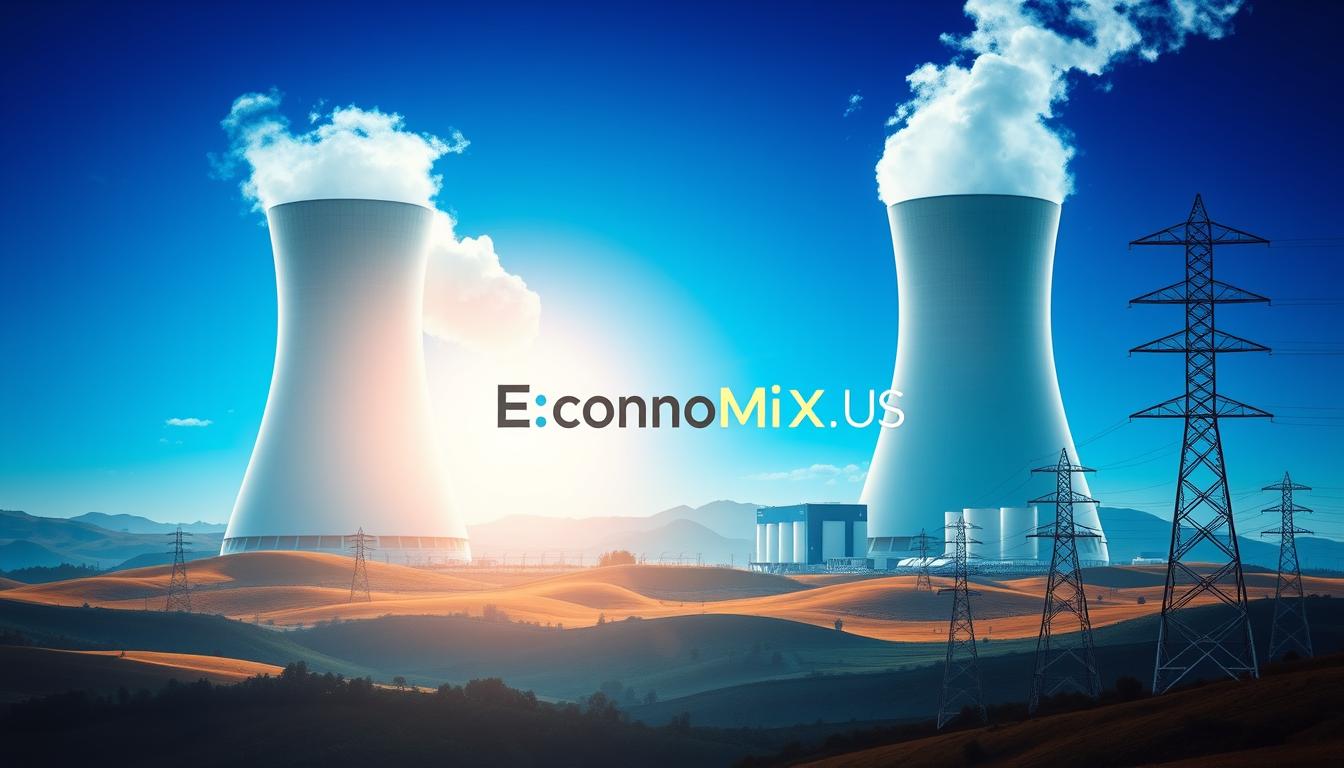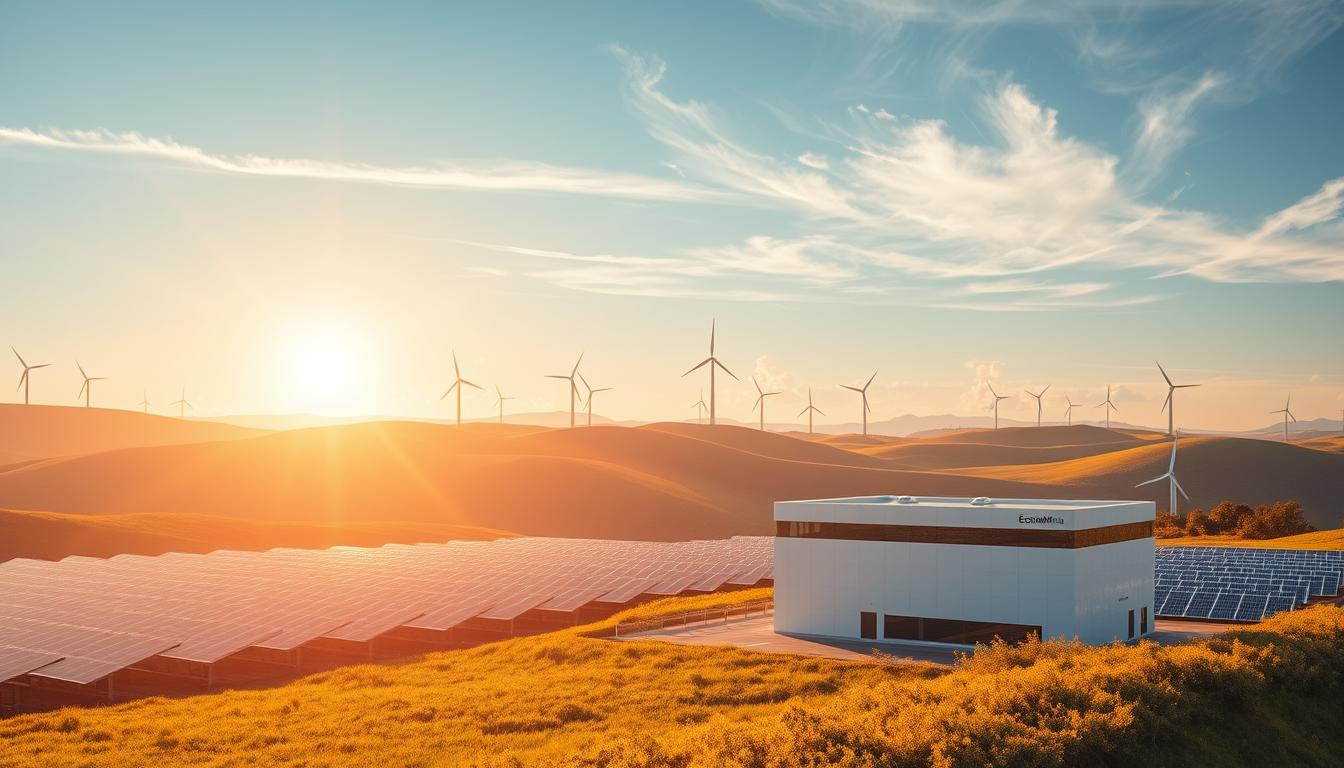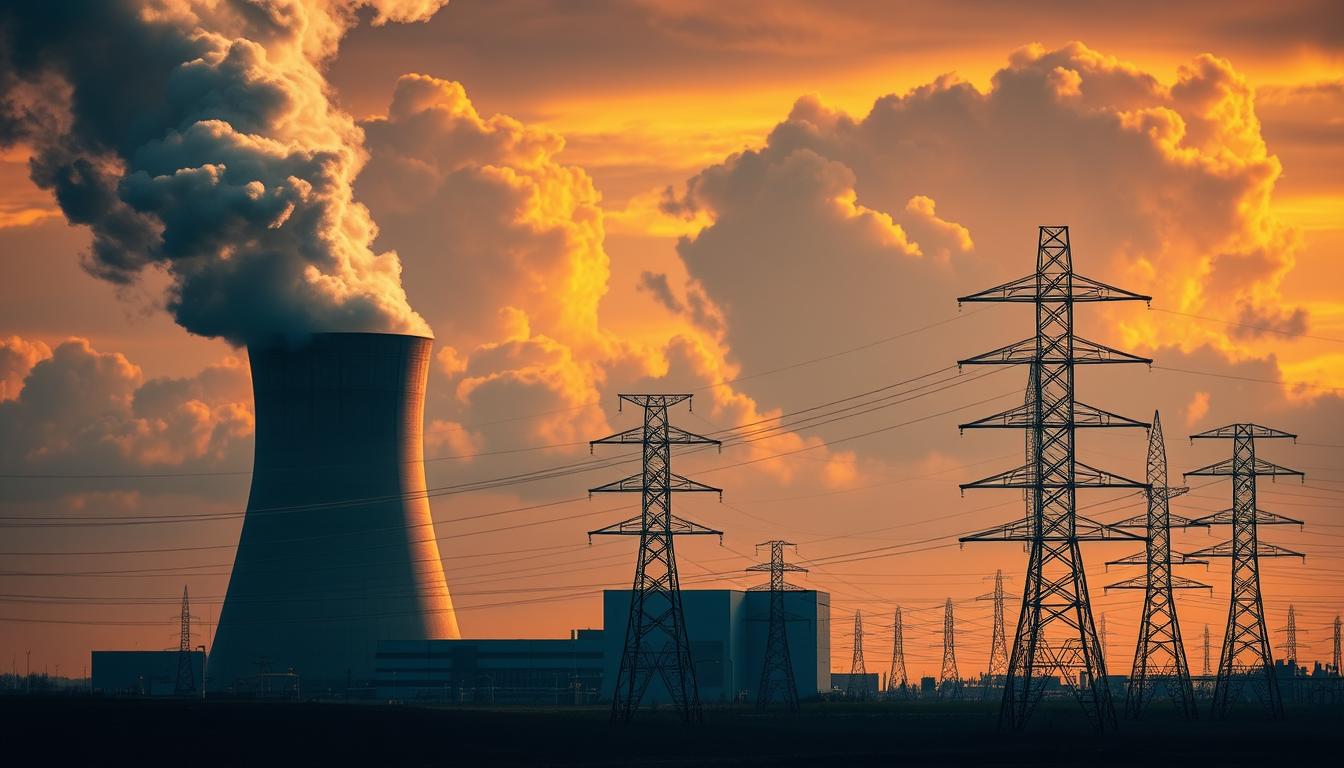With growing demands for clean and reliable electricity, many are asking: Can nuclear power drive economic growth while ensuring energy security? This question is at the heart of a global debate. Currently, nuclear generates 20% of U.S. electricity and over half of the nation’s clean power. Its role in reducing carbon emissions is undeniable.
By 2050, global nuclear capacity is projected to increase by 2.5 times. This growth is fueled by the need for clean, firm power to meet rising demands from industries like AI and data centers. These sectors alone consume energy equivalent to powering 11 million homes.
Despite its potential, the industry faces challenges. Regulatory hurdles and high upfront costs often deter investment. Yet, bipartisan support and private sector initiatives, such as FlexGen’s $75 million credit facility, signal a turning point. The question remains: Can nuclear power balance economic risks with long-term opportunities?
Key Takeaways
- Nuclear power supplies 20% of U.S. electricity and over 50% of clean energy.
- Global nuclear capacity is expected to grow 2.5 times by 2050.
- Rising energy demands from AI and data centers drive the need for clean power.
- Bipartisan support and private investments highlight nuclear’s potential.
- Regulatory challenges and high costs remain significant hurdles.
Introduction to Nuclear Energy’s Role in the Modern Economy
As global power needs surge, new nuclear power technologies are stepping into the spotlight. Its ability to provide clean, reliable electricity makes it a critical player in the energy landscape. From its early days in the 1950s to today’s advanced Gen IV designs, this technology has evolved significantly over the years.
The U.S. and UK have taken different approaches to workforce development. For example, the UK’s Hinkley Point C project created 23,500 construction jobs. Similarly, the U.S. Department of Energy’s Advanced Reactor Demonstration Program is driving innovation and growth in the field.
The Evolution of Nuclear Power in the Energy Sector
Nuclear power has come a long way since its inception. Early reactors laid the groundwork for today’s advanced technologies. Modern designs focus on safety, efficiency, and scalability. These advancements are crucial for meeting the growing demand for clean energy.
Projects like Google’s 500MW small modular reactor (SMR) deal with Kairos Power highlight the tech sector’s interest. Data centers and AI infrastructure require a stable baseload, which nuclear power can provide. This makes it an attractive option for industries with high energy needs.
Why Nuclear Energy is Gaining Attention in the U.S.
Policy support has been a key driver. Both Biden and Trump administrations have continued funding for the Advanced Reactor Demonstration Program. Private sector initiatives, like Constellation’s acquisition of Calpine Corp, also signal strong interest.
Local hiring practices, such as the 70% local workforce at Sizewell C, demonstrate the economic benefits. These projects not only create jobs but also strengthen the supply chain. As innovation continues, nuclear power is poised to play a larger role in energy security and economic growth.
The Economic Impact of Nuclear Energy
The economic influence of the nuclear sector extends far beyond power generation. It drives job creation, strengthens supply chains, and fuels regional growth. With significant investments and opportunities in new nuclear technologies, this industry is reshaping economies worldwide over the years. This landscape presents a unique opportunity for companies operating in the sector, making it a pivotal time for growth and innovation.
In the UK, the existing fleet contributes $123 billion to the economy. Projects like Sizewell C have a £8 billion supply chain impact, creating thousands of jobs. Similarly, Hinkley Point C has trained over 1,500 apprentices, highlighting the sector’s role in workforce development.
Job Creation and Workforce Development
The nuclear industry is a major employer, offering roles in construction, engineering, and operations. Apprenticeship programs, like those at Hinkley Point C, provide hands-on training and career pathways. These initiatives not only address skill gaps but also strengthen STEM education pipelines.
Small modular reactors (SMRs) require a different workforce compared to traditional plants. This shift opens new opportunities for specialized training and innovation. Programs like the DOE Loan Programs Office support these advancements, ensuring a skilled workforce for the future.
Contribution to GDP and Regional Growth
Nuclear power contributes 0.6% to the U.S. GDP, with regional multipliers boosting local economies. For example, Bridgwater saw a 10% productivity increase due to nearby projects. Such growth is driven by investments in infrastructure and supply chains.
EDF’s $8 billion investment in the UK supply chain demonstrates the sector’s economic potential. Similarly, Centrus Energy’s HALEU production highlights innovation in fuel efficiency. These efforts not only create jobs but also position regions as hubs for nuclear development.
| Project | Economic Impact | Key Metrics |
|---|---|---|
| Hinkley Point C | Job Creation | 1,500+ apprentices trained |
| Sizewell C | Supply Chain | £8 billion impact |
| UK Nuclear Fleet | GDP Contribution | $123 billion |
For more insights on the economics of nuclear power, visit this detailed resource.
Nuclear Energy and Energy Security
Energy security is a critical concern in today’s world, with nations seeking reliable solutions. As global power demands rise, the need for stable and consistent supply becomes paramount. This has brought renewed focus on nuclear technology as a key player in ensuring long-term stability.

One of the most significant advantages of nuclear power is its ability to reduce reliance on fossil fuels. Unlike solar or wind, which have lower capacity factors, nuclear plants operate at a 90% capacity factor. This makes them a dependable alternative to natural gas, which is often subject to price volatility.
France’s energy grid, which is 70% powered by nuclear, serves as a prime example. In contrast, Germany’s phaseout of nuclear has led to increased dependence on coal and gas. This divergence highlights the role of nuclear in enhancing energy security.
Reducing Reliance on Fossil Fuels
Nuclear power displaces natural gas generation, reducing the need for imports. For instance, the replacement of Indian Point in New York led to a significant drop in fossil fuel usage. This shift not only lowers emissions but also strengthens national energy independence.
Projects like X-energy’s partnership with Amazon for small modular reactors (SMRs) further illustrate this trend. These SMRs are designed to provide clean, reliable power to data centers, which consume vast amounts of energy. By integrating nuclear into their operations, companies can ensure a stable supply while reducing their carbon footprint.
Strengthening National Energy Independence
The U.S. is making strides toward fuel cycle security with its HALEU independence timeline. High-Assay Low-Enriched Uranium (HALEU) is essential for advanced reactors, and domestic production ensures a secure supply chain. This reduces dependence on foreign sources and enhances energy security.
Microreactor designs, like those from Last Energy, offer additional benefits. These compact reactors can power industrial facilities, providing a decentralized energy solution. Such innovations are crucial for building a resilient energy infrastructure.
| Country | Nuclear Share | Impact on Energy Security |
|---|---|---|
| France | 70% | Reduced reliance on gas and coal |
| Germany | 0% (Phaseout) | Increased fossil fuel usage |
| U.S. | 20% | Enhanced supply chain security |
By addressing fuel cycle challenges and investing in advanced technologies, nations can strengthen their energy security. Nuclear power offers a path toward a more stable and independent future.
Nuclear Energy’s Role in Clean Energy Transition
The transition to clean energy is reshaping global power systems. As nations aim for carbon neutrality, advanced technologies are playing a pivotal role. This shift is driven by the need to reduce emissions and ensure a sustainable future.

With lifecycle emissions of just 92g CO2/kWh, this approach offers a low-carbon solution. The Vogtle project, for example, avoids 17 million tons of CO2 annually. Such efforts are critical for meeting climate goals.
Carbon Reduction and Climate Goals
Clean energy sources are essential for reducing greenhouse gases. In the UK, 14% of electricity comes from this method, showcasing its potential. Projects like Diablo Canyon in California highlight its role in climate strategies.
NuScale’s plans to transition from coal demonstrate innovation in this field. Their small modular reactors (SMRs) provide a scalable solution. This technology is key to achieving long-term sustainability.
Complementing Renewable Energy Sources
Renewable sources like wind and solar are vital but face challenges. Grid inertia requirements with 80% renewables can strain systems. This is where nuclear complements these sources effectively.
France’s hybrid model combines both methods for a balanced approach. TerraPower’s Natrium reactor integrates storage, enhancing reliability. Such innovations ensure a stable and resilient energy grid.
| Project | Impact | Key Metrics |
|---|---|---|
| Vogtle | CO2 Avoidance | 17M tons annually |
| Diablo Canyon | Climate Role | Supports California’s goals |
| NuScale | Coal Transition | SMRs for scalability |
Challenges in Nuclear Energy Deployment
Deploying advanced power solutions comes with its own set of hurdles. From high initial costs to regulatory complexities, these challenges can slow progress. Addressing them is crucial for scaling up clean electricity generation.

High Initial Costs and Long Project Timelines
One of the biggest barriers is the significant upfront investment required. For example, the Vogtle project in Georgia saw costs balloon to $35 billion, far exceeding its initial $14 billion estimate. Such overruns can deter investors and delay deployment.
First-of-a-kind (FOAK) projects often face higher costs compared to subsequent builds. This is due to design complexities and supply chain inefficiencies. Reducing these costs is essential for wider adoption.
Timelines also pose a challenge. The NRC’s median license review time is 42 months, which can slow development. Streamlining this process could accelerate project completion.
Regulatory Hurdles and Public Perception
Regulatory frameworks can be both a safeguard and a bottleneck. While they ensure safety, lengthy approval processes can hinder progress. The NRC’s proposed 24-month licensing rule aims to address this issue.
Public perception also plays a role. In the U.S., 60% of people support nuclear power, compared to just 35% in Germany. Overcoming “not in my backyard” opposition is critical for new projects.
Financing models, like the UK’s RAB approach for Sizewell C, offer innovative solutions. These models can help mitigate risks and attract investment, ensuring smoother deployment.
Technological Advancements in Nuclear Energy
Innovation is driving a new era in advanced power technologies, reshaping how we generate electricity. From small modular reactors (SMRs) to cutting-edge safety features, these breakthroughs are transforming the industry. Companies are pushing boundaries to deliver cleaner, more efficient solutions.
Small Modular Reactors (SMRs) and Their Potential
SMRs are gaining traction as a scalable and cost-effective option. NuScale’s 77MW VOYGR design is a prime example, offering flexibility for diverse applications. X-energy’s TRISO fuel, with its 1600°C tolerance, ensures enhanced safety and performance.
Comparisons between GE Hitachi’s BWRX-300 and Rolls-Royce’s SMR highlight varying approaches. While the BWRX-300 focuses on simplicity, Rolls-Royce emphasizes standardization. Both aim to reduce costs and improve deployment timelines.
Oklo’s 1.5MW Aurora microreactor demonstrates the potential for decentralized power. Its compact size makes it ideal for remote locations or industrial facilities. These advancements are paving the way for a more resilient energy grid.
Innovations in Reactor Design and Safety
Modern designs prioritize safety and efficiency. The AP1000 reactor, for instance, incorporates passive safety systems that require no human intervention. This ensures reliable operation even in emergencies.
Molten salt reactors address corrosion challenges with advanced materials. Companies like Ultra Safe Nuclear are using fully ceramic microcapsules to enhance durability. These innovations are critical for long-term reliability.
3D printing is revolutionizing SMR construction. It reduces costs and speeds up production while maintaining high precision. Gen IV reactors, with their improved efficiency, are setting new benchmarks for clean power generation.
| Technology | Key Feature | Impact |
|---|---|---|
| NuScale VOYGR | 77MW capacity | Scalability |
| X-energy TRISO | 1600°C tolerance | Enhanced safety |
| Oklo Aurora | 1.5MW microreactor | Decentralized power |
Investment Opportunities in Nuclear Energy
Investors are increasingly recognizing the potential of advanced power solutions. With growing demand for clean and reliable electricity, funding models are evolving to support next-generation projects. Both private and public sectors are collaborating to drive growth in this field.
Private Sector Interest and Funding Models
The private sector is playing a pivotal role in advancing innovative technologies. Amazon’s $500 million commitment to small modular reactors (SMRs) highlights the tech industry’s interest. Similarly, Brookfield’s $750 million investment in Westinghouse underscores the potential for long-term growth.
Financing models like Build-Own-Operate (BOO) and Build-Operate-Transfer (BOT) are gaining traction. These approaches reduce risks for investors while ensuring project completion. Constellation’s REIT conversion is another example of innovative funding strategies.
“The private sector’s involvement is critical for scaling up clean power solutions,” says an industry expert.
Government Incentives and Policy Support
Government initiatives are also driving investment. The DOE’s $6 billion civil nuclear credit program provides financial support for existing facilities. Additionally, the Inflation Reduction Act’s 45X tax credit incentivizes new projects.
Production tax credit extensions and the $1.5 billion HALEU availability fund further bolster growth. The UK’s £20 million fusion investment fund demonstrates international commitment to innovative solutions.
| Initiative | Funding | Impact |
|---|---|---|
| DOE Civil Nuclear Credit | $6 billion | Supports existing facilities |
| Amazon SMR Commitment | $500 million | Drives tech sector interest |
| UK Fusion Fund | £20 million | Advances innovative solutions |
Venture capital inflows reached $3.4 billion in 2023, signaling strong investor confidence. These opportunities are reshaping the future of clean power, ensuring sustainable growth for years to come.
Nuclear Energy and the Future of Power Demand
As industries evolve, the demand for reliable power solutions is skyrocketing. Data centers, AI, and industrial growth are driving unprecedented needs for clean and stable electricity. This surge is reshaping how we think about supply and infrastructure.
Meeting the Needs of Data Centers and AI
Data centers consume vast amounts of electricity, equivalent to powering 11 million homes by 2050. Companies like Equinix are securing 100MW power purchase agreements to meet this demand. These agreements ensure a stable supply for hyperscalers and tech giants.
Microsoft’s negotiations with ERCOT highlight the challenges of integrating clean power into existing grids. Hyperscalers are adopting innovative strategies to secure reliable energy sources. This trend underscores the importance of scalable solutions like small modular reactors (SMRs).
Supporting Industrial and Technological Growth
Industries like steel and aluminum are also driving power demand. Dow Chemical’s partnership with X-energy for SMRs demonstrates how advanced technologies can meet industrial needs. These collaborations are critical for decarbonizing heavy industries.
Nucor’s direct reduced iron (DRI) plant electrification is another example. Koch Industries’ investments in nuclear solutions further highlight the sector’s potential. These efforts are essential for achieving sustainable growth.
| Industry | Initiative | Impact |
|---|---|---|
| Data Centers | Equinix PPAs | 100MW supply |
| Steel | Nucor DRI Plant | Decarbonization |
| AI | Microsoft ERCOT | Grid integration |
Regional transmission constraints add complexity to these efforts. Addressing these challenges requires innovative solutions and collaboration. The future of power supply depends on our ability to meet these evolving demands.
Global Perspectives on Nuclear Energy
Across the globe, nations are adopting diverse strategies to meet their power needs. From large-scale projects to innovative technologies, the nuclear industry plays a pivotal role in shaping the future of electricity generation. Countries are leveraging their resources to build robust supply chains and enhance energy security.
The UAE’s Barakah plant, costing $24.4 billion, exemplifies the scale of modern projects. Meanwhile, China is constructing 21 reactors, showcasing its commitment to expanding its share in the global market. Russia’s Rosatom, with a $133 billion order book, highlights its dominance in the nuclear industry.
Lessons from International Programs
France’s EPR and South Korea’s APR-1400 reactors offer valuable insights. Both designs focus on efficiency and safety, but their export strategies differ. Saudi Arabia’s ambitious 17GW plan aims to diversify its energy mix, while Japan’s reactor restarts post-Fukushima demonstrate resilience.
Poland’s $40 billion deal with Westinghouse underscores the growing demand for advanced solutions. South Africa’s procurement delays, however, highlight challenges in execution. India’s PHWR fleet expansion and Argentina’s CAREM-25 SMR progress reflect regional innovation.
The U.S. Position in the Global Market
The U.S. faces export control challenges but remains a key player. Westinghouse’s VVER fuel replacement initiative strengthens its supply chain presence. With a focus on long-term security, the U.S. is poised to maintain its leadership in the global market.
| Country | Initiative | Impact |
|---|---|---|
| UAE | Barakah Plant | $24.4 billion investment |
| China | 21 Reactors | Expanding capacity |
| Russia | Rosatom Orders | $133 billion order book |
Risks Associated with Nuclear Energy
Balancing progress with safety remains a critical challenge in power generation. While advanced technologies offer immense potential, they also come with significant hurdles. Understanding these risks is essential for sustainable development.
Safety Concerns and Waste Management
One of the most pressing issues is the management of spent fuel. The U.S. currently holds over 90,000 metric tons of inventory, posing long-term storage challenges. Addressing this requires innovative solutions like recycling, which can reduce waste but comes with high costs.
Safety protocols are another critical area. The Fukushima disaster, with over $100 billion in costs, underscores the need for robust measures. Modern designs incorporate advanced features, but the risk of accidents remains a concern.
- Analyze the cost implications of aircraft impact rules.
- Compare waste profiles of CANDU and LWR reactors.
- Detail how lithium shortages impact small modular reactors.
Economic Risks and Market Volatility
High upfront costs and financing challenges often deter investment. Projects like V.C. Summer, which faced cancellation, highlight the financial risks involved. Market volatility, such as the 40% year-to-date increase in natural uranium prices, adds further complexity.
Supply chain dependencies also pose threats. For instance, reliance on Russian HEX for uranium enrichment creates vulnerabilities. Addressing these gaps is crucial for long-term stability.
“Economic risks must be carefully managed to ensure the viability of advanced power projects,” says an industry expert.
Insurance policies with war exclusion clauses and interest rate sensitivity further complicate financing. These factors must be addressed to attract investment and ensure project success.
Conclusion: The Path Forward for Nuclear Energy
The future of power generation hinges on innovation and strategic planning. Small modular reactors (SMRs) and large-scale reactors each offer unique pathways for growth. SMRs provide flexibility, while traditional plants ensure high-capacity output. Both require a skilled workforce and streamlined regulatory processes.
Modernizing the NRC is urgent to accelerate deployment. The DOE’s 2024-2028 strategic plan emphasizes public-private partnerships. These collaborations can drive investment and foster innovation. Projects like Vogtle Unit 4 demonstrate the potential of standardized designs.
International collaboration is essential for advancing technology and ensuring security. The UK’s 22GW target by 2050 and the ADVANCE Act timeline highlight global commitment. By focusing on these priorities, the industry can achieve 2030 deployment targets and meet rising power demands.














